OLDSMOBILE SILHOUETTE 1993 Manual PDF
Manufacturer: OLDSMOBILE, Model Year: 1993, Model line: SILHOUETTE, Model: OLDSMOBILE SILHOUETTE 1993Pages: 323, PDF Size: 17.13 MB
Page 71 of 323
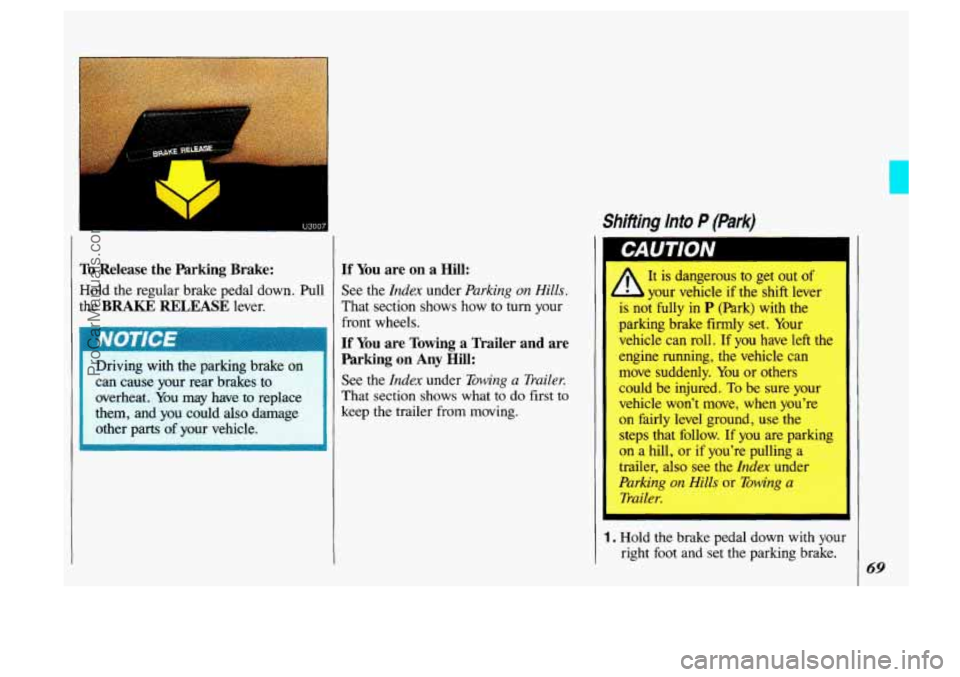
To Release the Parking Brake:
Hold the regular brake pedal down. Pull
the BRAKE RELEASE lever.
Driving with the parking brake
on
can cause your rear brakes to
overheat. You may have to replace
them, and you could also damage
i other parts of your vehicle. .. , m
If You are on a Hill:
See the Index under Parking on Hills.
That section shows how to turn your
front wheels.
If You are Towing a Trailer and are
Parking on Any Hill:
See the Index under Towing a Trailer.
That section shows what to do first to
keep the trailer
from moving.
Shiithg Into P (Park)
1
A
It is dangerous to get out 01
your vehicle if the shift lever
is not fully in
P (Park) with the
parking brake
firmly set. Your
vehicle can roll. If you have left
engine running, the vehicle can
move suddenly. You or others
could be injured.
To be sure your
vehicle won't move, when you're
on fairly level ground, use the
steps that follow.
If you are parking
on a hill,
or if you're pulling a
trailer, also see the Index under
Parking on Hills or Towing a
Trailer.
I
1. Hold the brake pedal down with your
right
foot and set the parhng brake.
69
ProCarManuals.com
Page 72 of 323
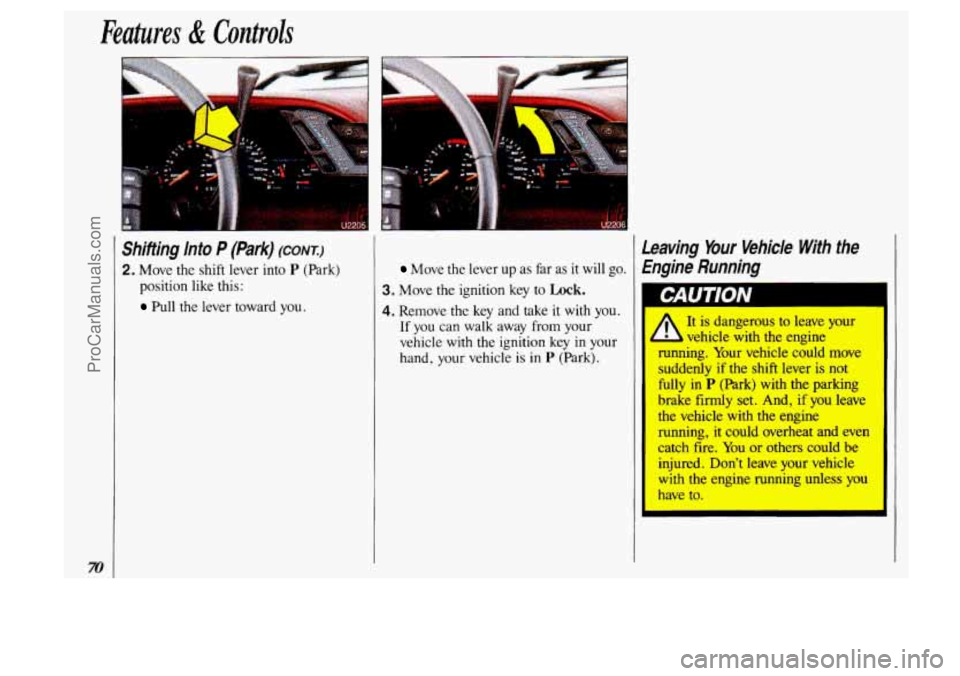
Features & Controls
I
Shifting Info P (Park) (CONI)
2. Move the shift lever into P (Park)
position like this:
Pull the lever toward you.
Leaving Your Vehicle With the
Move the lever up as far as it will go. Engine Running
3. Move the ignition key to Lock.
4. Remove the key and take it with you. I
If you can walk away from your
vehicle with the ignition key in yc
hand, your vehicle
is in P (Park).
1 CAUTION
ProCarManuals.com
Page 73 of 323
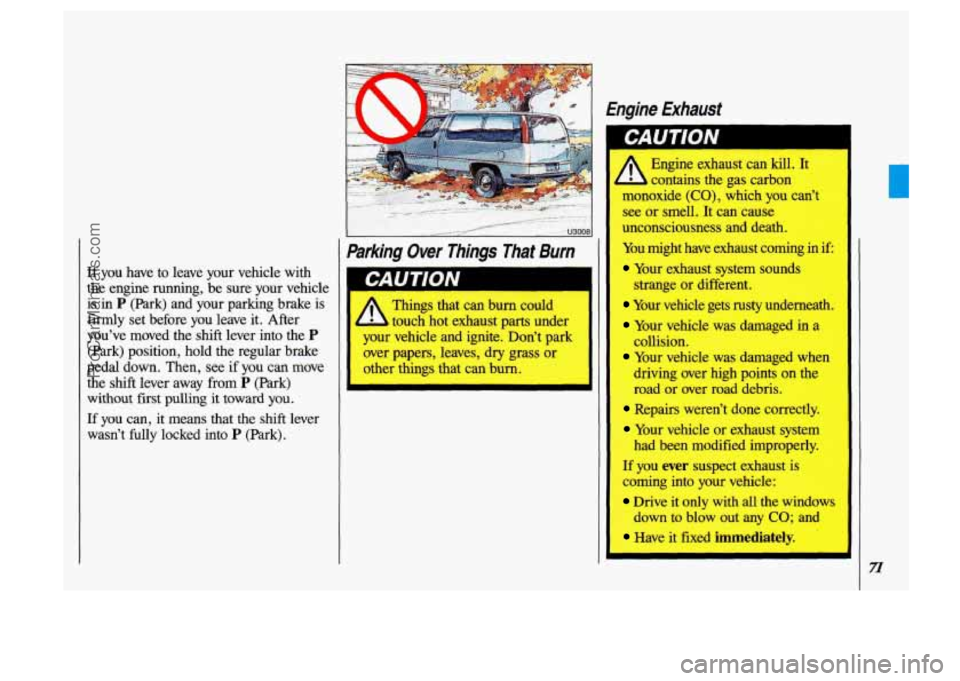
Engine Exhaust
If you have to leave your vehicle with
the engine
running, be sure your vehicle
is
in P (Park) and your parking brake is
firmly set before you leave it. After
you've moved the
shift lever into the P
(Park) position, hold the regular brake
pedal down. Then, see
if you can move
the shift lever away from
P (Park)
without first pulling
it toward you.
If you can, it means that the shift lever
wasn't fully locked into
P (Park).
I /.<*-- -+--,sa
Parking Over Things That Burn
Things that can burn could
touch hot exhaust
parts under I
A
Engine exhaust can kill. It
contains the gas carbon
monoxide
(CO), which you can't
see or smell. It can cause
unconsciousness and death.
You might have exhaust coming
in if
Your exhaust system sounds
strange or different.
1 I Your vehicle gets rusty underneath.
, Your vehicle was damaged in a
your vehicle and ignite: Don't park collision.
over
papers, leaves, dry grass or Your vehicle was damaged when
other things that can burn. driving over high points on the
Repairs weren't done correctly.
Your vehicle or exhaust system
had been modified improperly.
road
or over road debris.
If
you ever suspect exhaust is
coming into your vehicle:
Drive it only with all the windows
down to blow out any CO; and
Have it fixed immediately.
n
ProCarManuals.com
Page 74 of 323
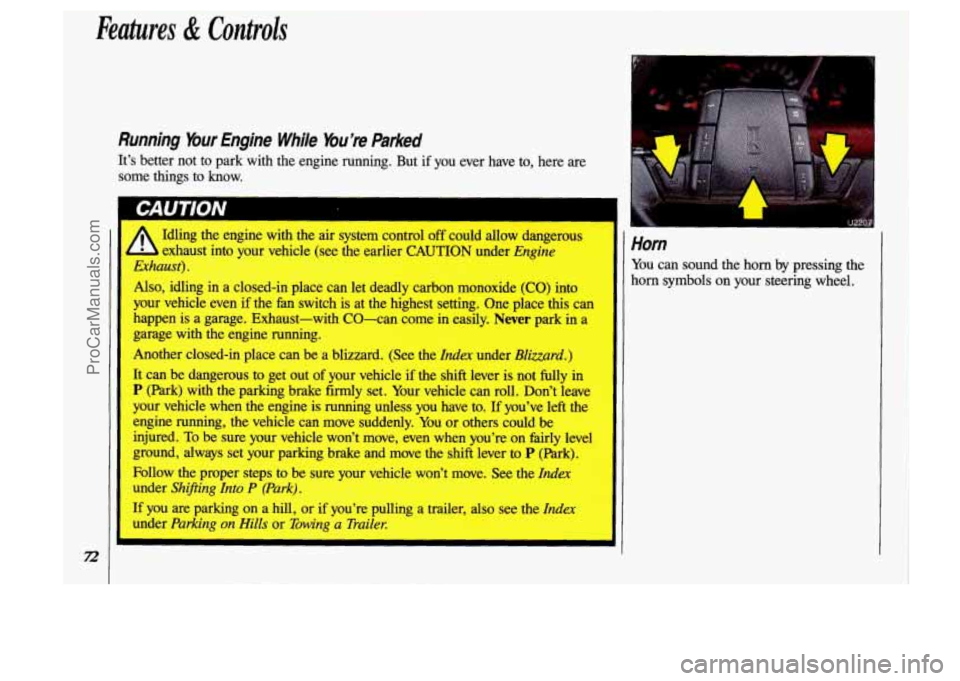
Features & Controls
n
Running bur Engine While You’re Parked
It’s better not to park with the engine running. But if you ever have to, here are
some things to know.
LAU I IUlV
A
Idling the engine with the air system control off could allow dangerous
exhaust into your vehicle (see the earlier CAUTION under
Engine
Exhaust).
Also, idling in a closed-in place can let deadly carbon monoxide (CO) into
your vehicle even if the fan switch
is at the highest setting. One place this can
happen is a garage. Exhaust-with CO-can come in easily.
Never park in a
garage with the engine running.
Another closed-in place can be a blizzard. (See the
Index under Blizzard.)
It can be dangerous to get out of your vehicle if the shift lever is not fully in
P (Park) with the parking brake firmly set. Your vehicle can roll. Don’t leave
your vehicle when the engine is running unless you have to.
If you’ve left the
engine running, the vehicle can move suddenly. You or others could be
injured.
To be sure your vehicle won’t move, even when you’re on fairly level
ground, always set your parking brake and move the shift lever to
P (Park).
Follow the proper steps to be sure your vehicle won’t move. See the
Index
under Shifing Into P (Park).
If you are parking on a hill, or if you’re pulling a trailer, also see the Index
under Parking on Hills or Towing a Trailer.
Horn
You can sound the horn by pressing the
horn symbols on your steering wheel.
ProCarManuals.com
Page 75 of 323
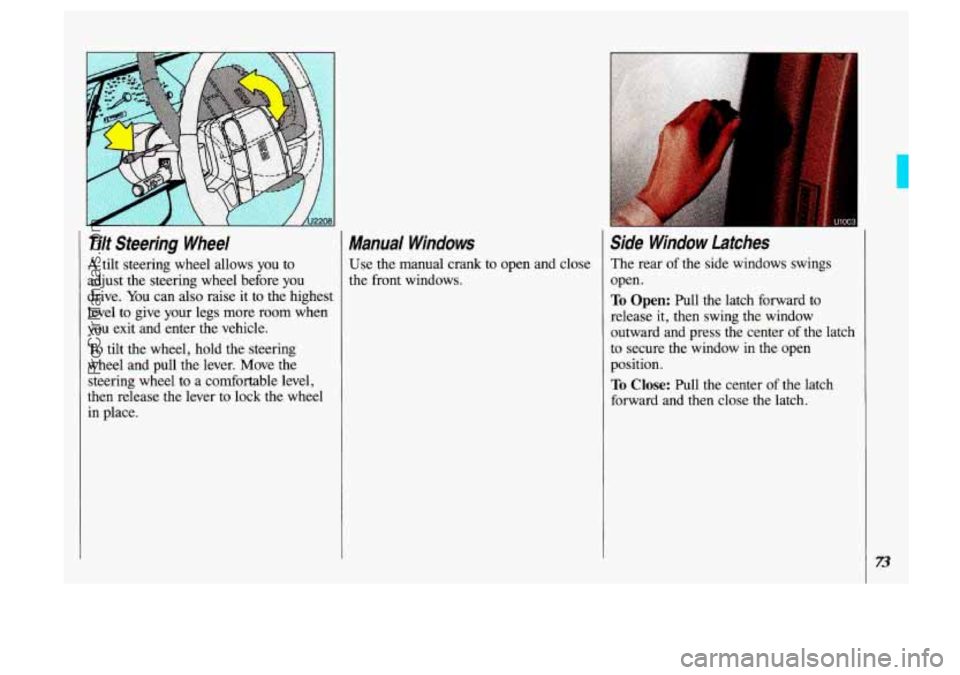
.-
Tilt Steering Wheel
A tilt steering wheel allows you to
adjust the steering wheel before you
drive. You can also raise it to the highest
level to give your legs more room when
you exit and enter the vehicle.
To tilt the wheel, hold the steering
wheel and pull
the lever. Move the
steering wheel to a comfortable level,
then release the lever to lock the wheel
in place.
Manual Windows
Use the manual crank to open and close
the front windows.
Side Window Latches
The rear of the side windows swings
open.
To Open: Pull the latch forward to
release it, then swing the window
outward and press the center
of the latch
to secure the window in the open
position.
To Close: Pull the center of the latch
forward and then close the latch.
ProCarManuals.com
Page 76 of 323
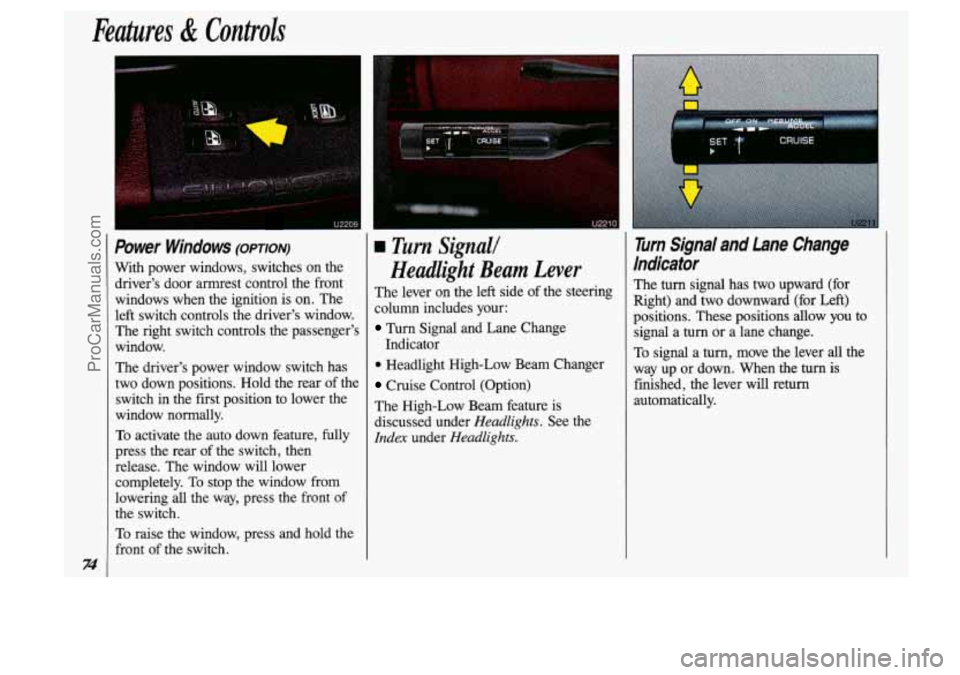
Features & Controls
74
I
Power Windows (omon)
With power windows, switches on the driver's door armrest control the front
windows when the ignition is on. The
left switch controls the driver's window. The right switch controls the passenger's
window.
The driver's power window switch has
two down positions. Hold the rear of the
switch
in the first position to lower the
window normally.
To activate the auto down feature, fully
press the rear of the switch, then
release. The window will lower
completely.
To stop the window from
lowering
all the way, press the front of
the switch.
To raise the window, press and hold the
front of the switch.
u2210
a Turn Signall
Headlight Beam Lever
The lever on the left side of the steering
column includes your:
Turn Signal and Lane Change
Indicator
0 Headlight High-Low Beam Changer
Cruise Control (Option)
The High-Low Beam feature is
discussed under
Headlights. See the
Idex under Headlights.
r CRUISE
I
Turn Signal and Lane Change
Indicator
The turn signal has two upward (for
Right) and two downward
(for Left)
positions. These
positions allow you to
signal a
turn or a lane change.
To signal a
turn, move the lever all the
way up or down. When the
turn is
finished, the lever will
return
automatically.
ProCarManuals.com
Page 77 of 323
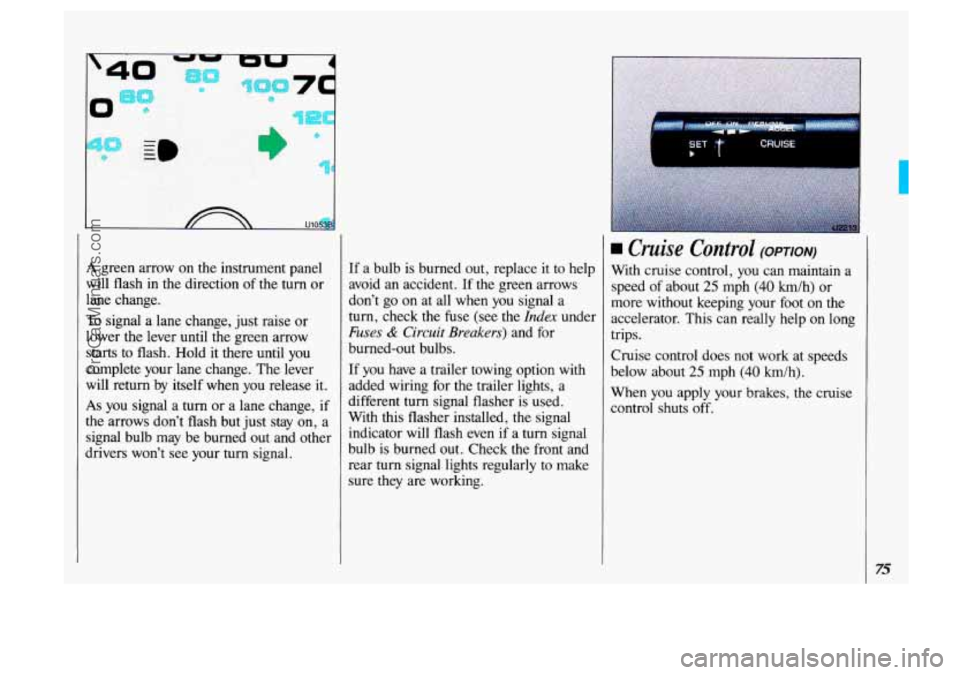
I
I&
A green arrow on. the instrument panel
will flash in the direction of the turn or
lane change.
To signal a lane change, just raise or
lower
the lever until the green arrow
starts to flash. Hold it there until you
complete your lane change. The lever
will return by itself when
you release it.
As you signal a turn or a lane change, if
the arrows don’t flash but just stay on, a
signal bulb may be burned out and other
dhvers won’t see your turn signal. If
a bulb is burned out, replace
it to help
avoid an accident. If the green arrows
don’t go on at all when you signal a
turn, check the fuse (see the
Index under
Fuses & Circuit Breakers) and for
burned-out bulbs.
If you have a trailer- towing option with
added wiring for the trailer lights, a
different
turn signal flasher is used.
With this flasher installed, the signal
indicator will flash even if a turn signal
bulb is burned out. Check
the front and
rear turn signal lights regularly to make
sure they are working.
SET T CRUISE b I
Cruise Control (OPTION)
With cruise control, you can maintain a
speed
of about 25 mph (40 km/h) or
more without keeping your foot
on the
accelerator. This can really help
on long
trips.
Cruise control does not work at speeds
below about
25 mph (40 km/h).
When you apply your brakes, the cruise
control shuts off.
75
ProCarManuals.com
Page 78 of 323
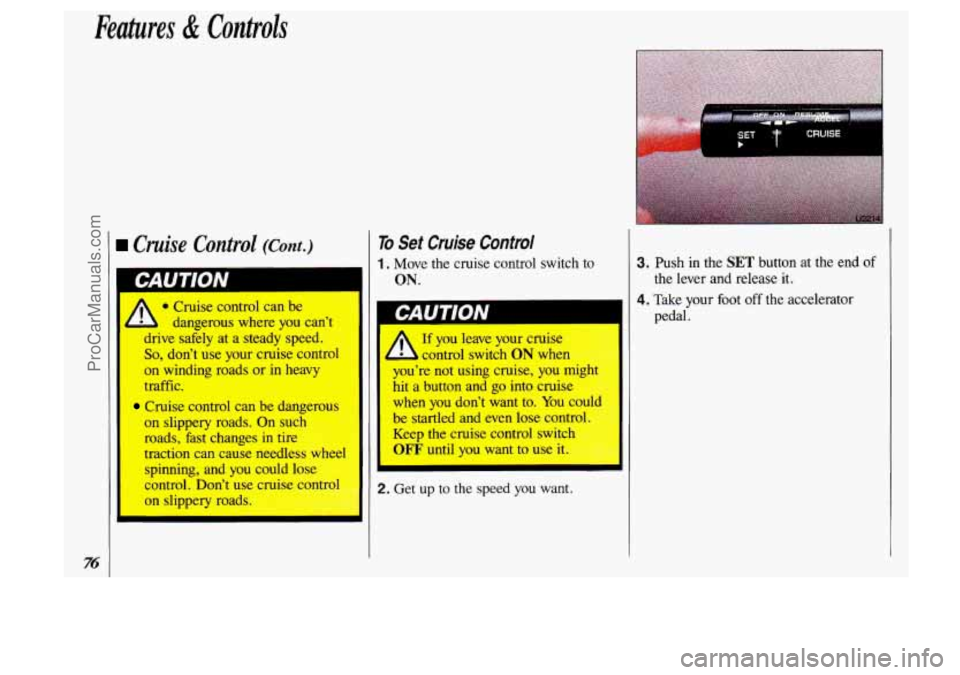
Features & Controls
76
Cruise Control (Cant.) I TO Set Cruise Control
drive safely at a steady speed.
So, don’t use your cruise control
on winding roads or in heavy
traffic.
Cruise control can be dangerow
on slippery roads. On such
roads, fast changes
in tire
traction can cause needless wheel spinning, and you could la
I IA
control. Don’t use cruise con
on slippery roads If you leave your
cruise
control switch
ON
you’re not using cruise, you might
hit a button and
go into cruise ;:$3
when you don’t want to. You could$g
be startled and even lose control
Keep the cruise control switch
OFF until you want to use it
2. Get up to the speed you want.
I
3. Push in the SET button at the end of
4. Take your foot off the accelerator
the lever and release
it.
pedal.
ProCarManuals.com
Page 79 of 323
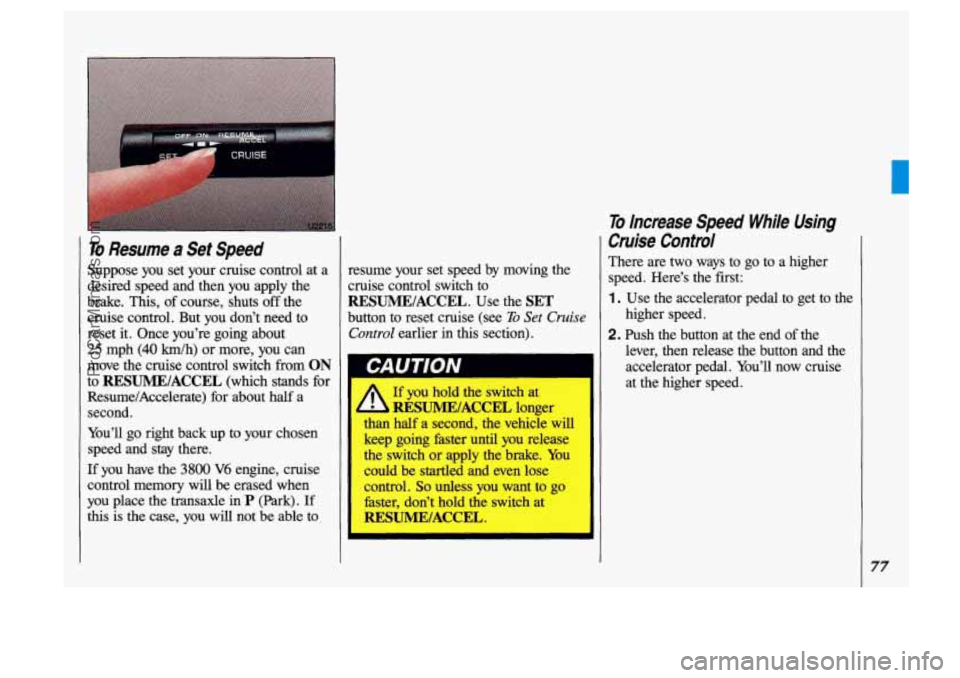
I To Resume a Set Speed
Suppose you set your cruise control at a
desired speed and then you apply the
brake. This,
of course, shuts off the
cruise control. But you don’t need to
reset it. Once you’re going about
25 mph (40 Wh) or more, you can
move the cruise control switch
from ON
to RESUME/ACCEL (which stands for
Resume/Accelerate) for about half a
second.
You’ll go right back up to your chosen
speed and stay there.
If you have the 3800 V6 engine, cruise
control memory
will be erased when
you place the transaxle
in P (Park). If
this is the case, you will not be able to resume your set speed
by moving the
cruise control switch to
RESUME/ACCEL. Use the SET
button to reset cruise (see To Set Cruise
Control earlier in this section).
If you hold the switch
at
than half a second, the vehicle will
keep going faster until you release
the switch or apply the brake. You
could be startled and even lose
control.
So unless you want to go
faster, don’t hold the switch at
RESUME/ACCEL.
I. RESUMEIACCEL longer
To Increase Speed Whl’le Using
Cruise Control
There are two ways to go to a higher
speed. Here’s the first:
1 . Use the accelerator pedal to get to the
2. Push the button at the end of the
higher speed.
lever, then release the button and the accelerator pedal. You’ll now cruise
at the higher speed.
77
ProCarManuals.com
Page 80 of 323
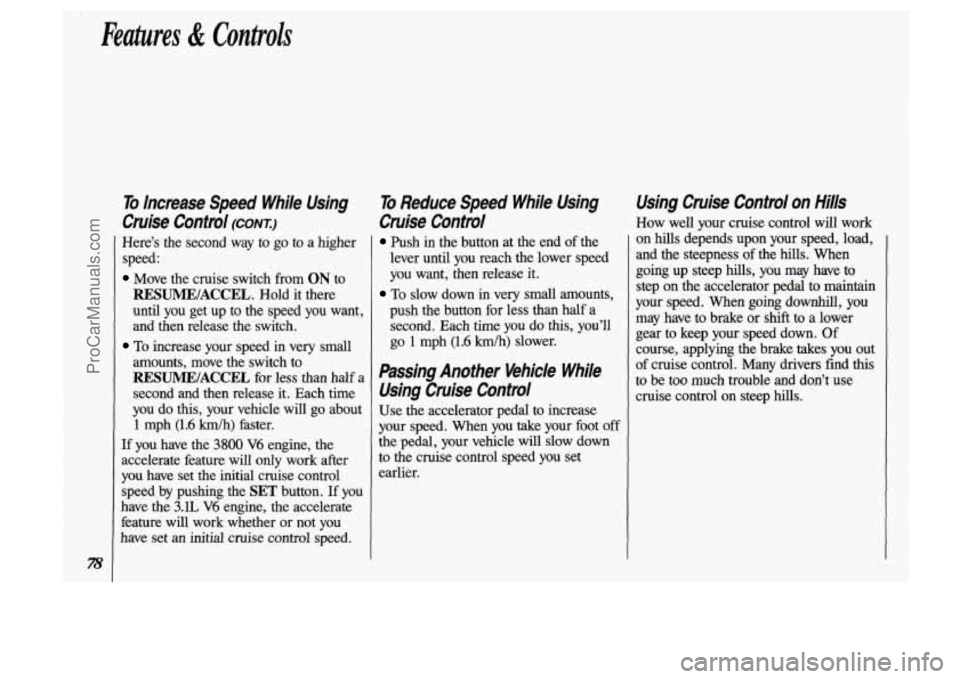
c
Features di Controls
To Increase Speed While Using
Cruise Control
(CONI)
Here’s the second way to go to a higher
speed:
Move the cruise switch from ON to
RESUME/ACCEL. Hold it there
until you get up to the speed you want,
and then release the switch.
amounts, move the switch to
RESUME/ACCEL for less than half a
second and then release it. Each time
you do this, your vehicle will go about
1 rnph (1.6 km/h) faster.
To increase your speed in very small
If you have the
3800 V6 engine, the
accelerate feature will only work after
you have set the initial cruise control
speed by pushing the
SET button. If you
have the
3.E V6 engine, the accelerate
feature will work whether or not you
have set an initial cruise control speed.
To Reduce Speed While Using
Cruise Control
Push in the button at the end of the
lever until you reach the lower speed
you want, then release it.
To slow down in very small amounts,
push the button for less than half a second. Each time
you do this, you’ll
go
1 mph (1.6 Wh) slower.
Passing Another Vehicle While
Using Cruise Control
Use the accelerator pedal to increase
your speed. When you take your foot off
the pedal, your vehicle
will slow down
to the cruise control speed you set
earlier.
Using Cruise Control on Hills
How well your cruise control will work
on
hills depends upon your speed, load,
and the steepness of the hills. When
going up steep hills, you may have to
step on the accelerator pedal to maintain
your speed. When going downhill, you
may have to brake or shift to a lower
gear to keep your speed down. Of course, applying the brake takes you out
of cruise control. Many drivers find this
to be too much trouble and don’t use
cruise control on steep hills.
ProCarManuals.com